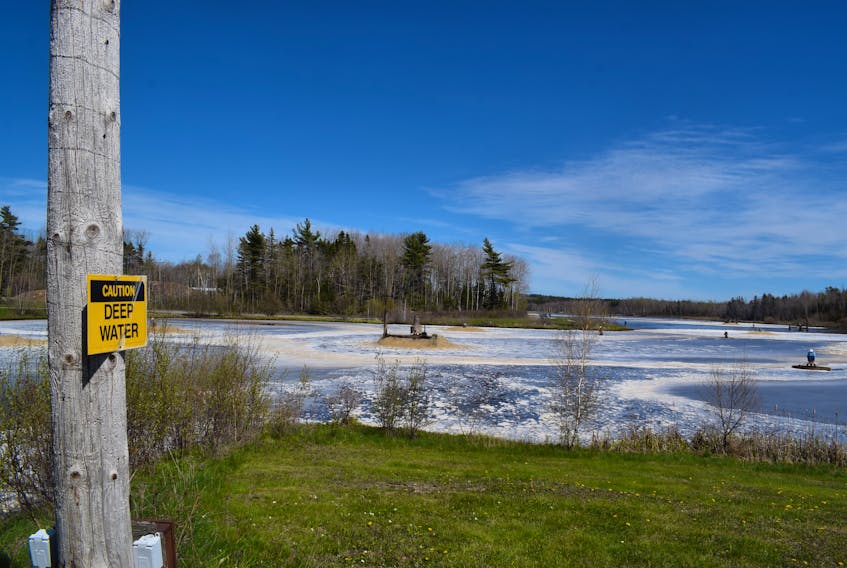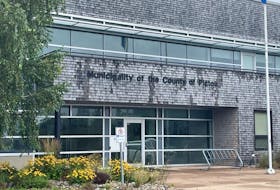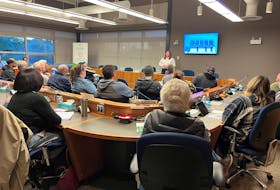PICTOU LANDING, N.S. — A public information session on the current state of the Boat Harbour remediation project was held at the Pictou Landing First Nation fire hall on August 1.
Doors opened at 2 p.m. and by 2:30 p.m. there had already been nearly 40 people from Pictou County inside the meeting room.
“I’ll be happy to see it gone,” said Warren Francis of Pictou landing First Nation. “It’s about time and I’d really like to see it go back to a tidal estuary.”
At this stage, the remediation project design are still being finalized, and it won’t be until after the federal Canadian Environmental Assessment Agency reviews the Environmental Impact Assessment in 2021 that the real work will get underway.
“The earliest we expect to be in a position to start remediation will be late 2021,” said project leader Ken Swain.
“If there are conditions that affect the design, then we’ll have to do a redesign which could maybe take a couple of months, and then we’ll be in a position to go to procurement,” said Swain who was at the fire hall on Aug. 1.
To get a sense of what it will look like to transform Boat Harbour back into the tidal estuary called A’Se'k by the people of Pictou Landing, a scaled-down pilot project was carried out between May 2018 and July 2019.
“We saw what was working and what wasn’t,” Swain told The News.
The pilot-scale testing involved sectioning-off a single cove of the Boat Harbor basin and determining, sometimes through trial and error, what the best strategy will be going forward.
“Basically, we’ve seen that dredging wet is what we need to do,” said Swain.
Dredging wet means that instead of draining an area of the basin and using excavators to remove the sludge collected on the bottom, the current plan will be to place a dredger on top of a barge platform that will remain on the surface of the water.
When they tried dredging dry, (removing the water first) the excavators sank into the sludge.
“We thought this was going to be the case. The bottom was too soft, and it wouldn’t support the equipment, so it led us to prove that dredging in the dry wouldn’t work.”
From there the plan would be for wet sludge sucked up from the bottom of the basin to be pumped onto a treatment pad.
Swain said that the watery sludge pumped onto the treatment pad is comprised of between five per-cent solid material. The plan will be to use geo-tubes, which separate those solids from the water like a cheese cloth.
“Basically, these geo tubes contain the sludge and allow the water to go through the mesh,” said Swain.
From there the sludge contained in the geo-tubes would be pumped into an existing containment cell. That containment cell was built in 1996 to hold contaminants from the treatment facility. According to Swain, it currently holds over 100,000 cubic metres of contaminated material.
In order to store what can reasonably be assumed will be a lot more contaminated sludge, Swain said that the containment cell will need to be refurbished.
“We plan on putting a new high density polyethylene liner in it,” he said. “And then at the end of the project we’ll put a cap over the top of it.” Swain also said that a new leaching collection system will be installed at the containment site.
For Francis, who spoke with Swain during the info session, there is a concern that the addition more contaminated sludge could cause the containment system to fail and cause leaks into the estuary.
“What’s the sense of cleaning something up if it’s going to just go back in there,” he said speaking with The News.
There are already monitoring wells around the current containment cell, and Swain said that they have been monitoring the integrity of the site.
“We’ve tested around the perimeter of the cell fairly extensively, and it’s not leaking. Swain added that the containment site will need to be monitored perpetually after remediation is complete.
The total cost of remediation is currently forecasted at $217 million.









